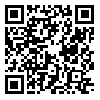Volume 7, Issue 3 (2019)
Health Educ Health Promot 2019, 7(3): 105-109 |
Back to browse issues page
Download citation:
BibTeX | RIS | EndNote | Medlars | ProCite | Reference Manager | RefWorks
Send citation to:



BibTeX | RIS | EndNote | Medlars | ProCite | Reference Manager | RefWorks
Send citation to:
Oveisi S, Zahedifar F, Atashgar E, Yadegary Z, Amole N, Taherkhanee S. Prediction of Dental Caries Preventive Behaviors using
Health Belief Model (HBM)
. Health Educ Health Promot 2019; 7 (3) :105-109
URL: http://hehp.modares.ac.ir/article-5-24988-en.html
URL: http://hehp.modares.ac.ir/article-5-24988-en.html
1- Education & Training Development Department, Health Faculty, Qazvin University of Medical Sciences, Qazvin, Iran
2- Education & Training Development Department, Health Faculty, Qazvin University of Medical Sciences, Qazvin, Iran ,zahedifar8285@gmail.com
3- Student Research Committee, Qazvin University of Medical Sciences, Qazvin, Iran
2- Education & Training Development Department, Health Faculty, Qazvin University of Medical Sciences, Qazvin, Iran ,
3- Student Research Committee, Qazvin University of Medical Sciences, Qazvin, Iran
Abstract: (7341 Views)
Aims: One of the most important factors in public health is oral and dental health. Determining the level of knowledge and attitude and the applicable criteria are effective factors in reducing dental problems. This study was conducted to determine the effective factors on oral hygiene based on the Health Belief Model (HBM) in students of Paramedicine, Qazvin University of Medical Sciences.
Materials & Methods: This is a descriptive-analytical. The present study was conducted on 300 students that were selected by using a multi-stage random sampling method. The data collection tool was based on a standard questionnaire of health belief model. The obtained data were analyzed by SPSS 20 software, descriptive statistics, and Pearson coefficient tests, variance analysis, Turkey test, and linear regression logistic regression was taken as a significant level of 0.05.
Findings: The mean of health behaviors among students was moderate (52.38±5.95). The regression analysis showed that constructs perceived barriers, self-efficacy and perceived benefits predict tooth decay prevention behaviors (p≤0.05). Pearson's test showed a positive and significant relationship between perceived barriers and behavior (r=-0.471, p=0.00).
Conclusion: In order to promote health behaviors among the student’s perceived barrier self-efficacy and perceived benefits, as the most important predictors of student behavior for holding educational courses should be used.
Materials & Methods: This is a descriptive-analytical. The present study was conducted on 300 students that were selected by using a multi-stage random sampling method. The data collection tool was based on a standard questionnaire of health belief model. The obtained data were analyzed by SPSS 20 software, descriptive statistics, and Pearson coefficient tests, variance analysis, Turkey test, and linear regression logistic regression was taken as a significant level of 0.05.
Findings: The mean of health behaviors among students was moderate (52.38±5.95). The regression analysis showed that constructs perceived barriers, self-efficacy and perceived benefits predict tooth decay prevention behaviors (p≤0.05). Pearson's test showed a positive and significant relationship between perceived barriers and behavior (r=-0.471, p=0.00).
Conclusion: In order to promote health behaviors among the student’s perceived barrier self-efficacy and perceived benefits, as the most important predictors of student behavior for holding educational courses should be used.
Article Type: Original Research |
Subject:
Health Promotion Approaches
Received: 2018/09/10 | Accepted: 2019/04/13 | Published: 2019/07/21
Received: 2018/09/10 | Accepted: 2019/04/13 | Published: 2019/07/21
References
1. Naderifar M, Peyrovi H, Galgay F. Mothers' attitude towards orodental health of their 1-6 years old children referred to medical centers of Zahedan city, 2006. Iran J Nurs. 2007;20(52):75-86. [Persian] [Link]
2. Zamani Alavijeh F. HBM trail in controlling tooth plaque in Arak primary school students in 2003-2004. Tabib Shargh J Zahedan Univ. 2005;4(2):9-15. [Persian] [Link]
3. Ndiokwelu E. Applicability of Rosenstock-Hochbaum health behavior model to prevention of periodontal disease in Enugu students. Odontostomatol Trop. 2004;27(106):4-8. [Link]
4. Khedmat S. Oral Diseases. Tehran: Tabib Publication; 2001. [Persian] [Link]
5. Pitts NB. Modern concepts of caries measurement. J Dent Res. 2004;83(Suppl 1):43-7. [Link] [DOI:10.1177/154405910408301s09]
6. Mohseni M, Mahbobi M, Sayadi AR, Shabani Z, Asadpour M. The effect of an educational intervention based on health belief model on the standard precautions among medical students of Rafsanjan University of Medical Sciences. Res Med Educ. 2015;7(1)63-72. [Persian] [Link] [DOI:10.18869/acadpub.rme.7.1.63]
7. Shamsi M, Sharifirad G, Kachoyee A, Hassanzadeh A. The effect of educational program walking based on Health Belief Model on control sugar in woman by type 2 diabetics. Iranian J Endocrinol Metab. 2010;11(5):490-9. [Persian] [Link]
8. Zhu L, Petersen PE, Wang HY, Bian JY, Zhang BX. Oral health knowledge, attitudes and behaviour of children and adolescents in China. Int Dent J. 2003;53(5):289-98. [Link] [DOI:10.1111/j.1875-595X.2003.tb00762.x]
9. Mehri A, Morowatisharifabad M. Utilizing the Health Promotion Model to predict oral health behaviors in the students of Islamic Azad University of Sabzevar(2008). J Dent Med. 2009;22(1):81-7. [Persian] [Link]
10. Solhi M, Shojaei Zadeh D, Seraj B, Faghih Zadeh S. A new model for oral health education. J Qazvin Univ Med Sci. 2000;3(4):3-11. [Persian] [Link]
11. Naidoo J, Wills J. Health Promotion: Foundations for Practice. Kent: Baillière Tindall; 2000. [Link]
12. Hajiamini K, Sharifirad G, Hasanzade A. The effect of oral health education based on Health Belief Model in Mothers who had 3-6 year old children on decreasing dental plaque index in Zanjan. J Zanjan Univ Med Sci. 2010;18(72):77-86. [Persian] [Link]
Send email to the article author
| Rights and permissions | |
 |
This work is licensed under a Creative Commons Attribution-NonCommercial 4.0 International License. |






